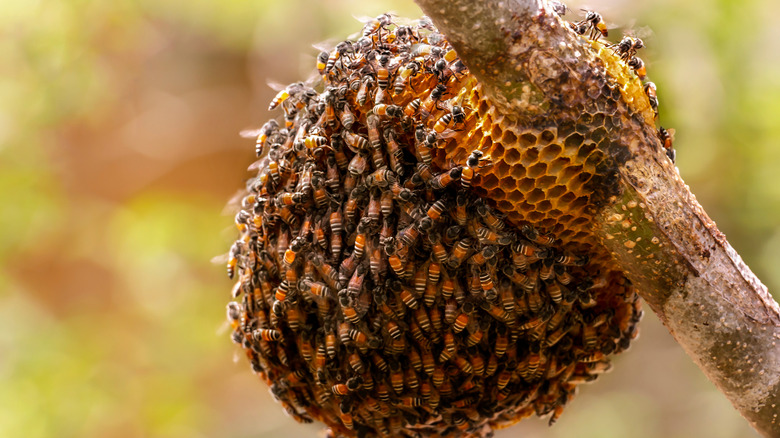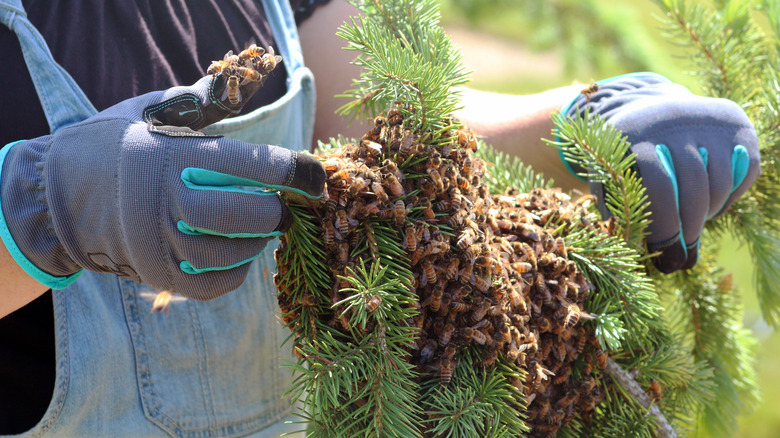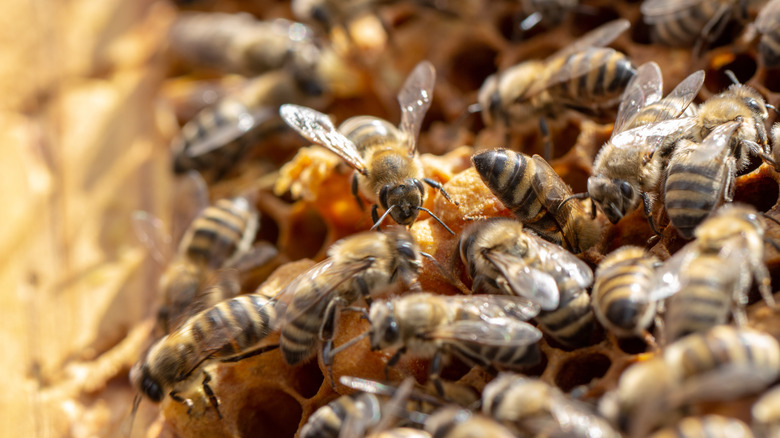Here's How Much It Costs To Get A Bee's Nest Professionally Removed
Seeing a bee's nest forming on your front porch or other frequently used outdoor area can be alarming. Sometimes, we don't even notice the buzzing bees working on their home until it has grown quite large. It's imperative you don't attempt to remove a bee's nest on your own for many reasons. Although some species are known for being gentle and unproblematic, even honey bees can get aggressive when their nests are disturbed, therefore, a professional should be called. According to Lawn Starter, hiring a professional can cost as little as $300 to as much as a couple thousand depending on factors like the size and the location of the nest, the type of bees present, and how long the process will take.
Aside from how hazardous it can be to mess with a bee's nest, we must also remember that these beneficial insects are at risk of extinction. Given how vital these pollinators are to our ecosystem, harming them should be avoided at all costs. Turning to a professional to safely remove a bee's nest will ensure the colony can find a new home in a better location where they can continue helping the environment.
The cost of professional bee's nest removal
As you seek to estimate the cost of hiring a professional to remove a bee's nest, start by determining the type of bee you're dealing with. Certain species will be more dangerous to tackle than others, directly impacting the cost of services. On average, bumblebees will range from $80 to $200, carpenter bees $100 to $600, and killer bees $150 to $800. If it's honeybees, consider looking into nearby beekeepers who might be interested in extracting them for free. While honeybees aren't the most dangerous, their colonies can reach up to 80,000 individual bees, meaning professional removal of them can cost up to $1,000.
Bee type is only part of the equation; nest size and location will increase the final sum. If a nest has gotten into your home's walls, windows, or attic, you can expect removal to be more expensive. Carpenter bees are the most problematic when it comes to a colony entering your house. Indoor removal can also add repair costs in the aftermath, so try to catch a swarm before it establishes a nest. Swarms consist of a queen bee that has split from an overpopulated pack and is seeking a new location, and they're actually cheaper to remove; the national average cost is $75. When you see a ball of hovering bees over an area, give it a day or two before calling a professional, as they may decide the area isn't ideal and move on.
Determining if a bee's nest is problematic
You may have noticed a bee's nest near your home but aren't sure if it's necessary to have it removed. Do what makes you feel the most comfortable. However, if the nest won't cause any trouble, it could save you money to leave it alone. Bees won't go out of their way to harm you, so establish whether you can avoid provoking the nest. While the further a nest is from your home, the less of a threat it poses, consider any children or pets affected if you leave it in place. Adults can easily avoid it, but our little ones won't have the same agency.
Also, remember that not all nests are found up high. Sweat bees, mason bees, and dreaded yellowjacket wasps form their nests in the ground. If you've determined that a nest is problematic, you must decide whether to extract or exterminate. Extermination costs between $150 to $500, and it involves poisoning the bees by emitting a toxin that can also be harmful to humans and animals. But, it is an affordable alternative to extraction, which is much more expensive. Extracting costs up to $1,000 in some cases. However, extraction only destroys the nest once the colony has safely been removed and ensures they won't try to reclaim their home. Lastly, understand that wasps should be dealt with more swiftly than bees. Wasps and hornets alike are more aggressive and harmful and thus should be approached with more caution.


